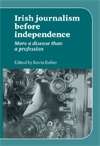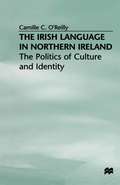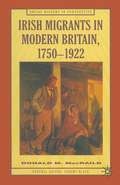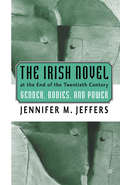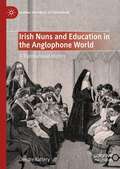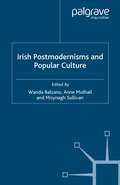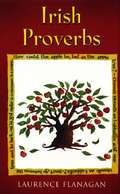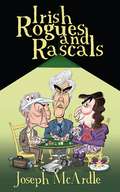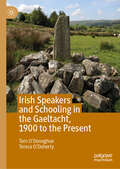- Table View
- List View
Irish Insanity: 1800–2000 (Routledge Advances in Sociology)
by Damien BrennanThe national public asylum system in Ireland was established during the early nineteenth century and continued to operate up to the close of the twentieth century. These asylums / mental hospitals were a significant physical and social feature of Irish communities. They were used intensively and provided a convenient form of institutional intervention to manage a host of social problems. Irish Insanity identifies the long-term trends in institutional residency through the development of a detailed empirical data set, based on an analysis of original copies of the reports of Inspector of Asylums/Mental Hospitals in Ireland. Damien Brennan explores core social and historical features linked to this data including: the political context governance and social policy the relationship between church and state changing economic structures and social deprivation professionalization legislation and systems of admission and discharge categorisation and diagnostic criteria international developments family dynamics This book demonstrates that the actual rate of asylum utilisation in Ireland was the highest by international standards, but challenges the idea that an "epidemic of Irish insanity" actually existed. Offering a historical and sociological insight into an institutional legacy that is unusual within the international context, this book will be of particular relevance and interest to scholars within the fields of sociology, criminology, law, history, Irish studies, social policy, anthropology, nursing and medicine.
Irish Insanity: 1800–2000 (Routledge Advances in Sociology)
by Damien BrennanThe national public asylum system in Ireland was established during the early nineteenth century and continued to operate up to the close of the twentieth century. These asylums / mental hospitals were a significant physical and social feature of Irish communities. They were used intensively and provided a convenient form of institutional intervention to manage a host of social problems. Irish Insanity identifies the long-term trends in institutional residency through the development of a detailed empirical data set, based on an analysis of original copies of the reports of Inspector of Asylums/Mental Hospitals in Ireland. Damien Brennan explores core social and historical features linked to this data including: the political context governance and social policy the relationship between church and state changing economic structures and social deprivation professionalization legislation and systems of admission and discharge categorisation and diagnostic criteria international developments family dynamics This book demonstrates that the actual rate of asylum utilisation in Ireland was the highest by international standards, but challenges the idea that an "epidemic of Irish insanity" actually existed. Offering a historical and sociological insight into an institutional legacy that is unusual within the international context, this book will be of particular relevance and interest to scholars within the fields of sociology, criminology, law, history, Irish studies, social policy, anthropology, nursing and medicine.
Irish Journalism Before Independence: More a disease than a profession
by Kevin RafterThey reported wars, outraged monarchs and promoted the case for their country’s freedom. The pages of Irish Journalism Before Independence: More a Disease than a Profession are filled with the remarkable stories of reporters, proprietors and propagandists. Sixteen leading writers celebrate the emergence of Irish Journalism in this original and engaging volume. These leading media academics, historians and scholars join in what is a festschrift travelling the long Irish nineteenth century to 1922. Their stories, narratives and histories illustrate the emergence of Irish journalism chronicling the evolution and development of the profession, and the various challenges confronted by the first generation of modern journalists. The profession’s past is framed by reference to its practitioners and their practice. Readers are treated to studies of foreign correspondents, editorial writers, provincial newspaper owners, sports journalists and the challenges of minority language journalism. The volume goes beyond Ireland to explore the work of Irish journalists abroad and shows how the great political debates about Ireland’s place in the United Kingdom served as a backdrop to newspaper publication in the nineteenth and early twentieth centuries. In his preface Professor James Curran concludes that the volume “advances by leaps and bounds the history of the Irish press”. The collection makes valuable and important contribution to our knowledge of Irish journalism - and like all good reportage it offers its readers a very good read.
Irish Journalism Before Independence: More a disease than a profession
by Kevin RafterThey reported wars, outraged monarchs and promoted the case for their country’s freedom. The pages of Irish Journalism Before Independence: More a Disease than a Profession are filled with the remarkable stories of reporters, proprietors and propagandists. Sixteen leading writers celebrate the emergence of Irish Journalism in this original and engaging volume. These leading media academics, historians and scholars join in what is a festschrift travelling the long Irish nineteenth century to 1922. Their stories, narratives and histories illustrate the emergence of Irish journalism chronicling the evolution and development of the profession, and the various challenges confronted by the first generation of modern journalists. The profession’s past is framed by reference to its practitioners and their practice. Readers are treated to studies of foreign correspondents, editorial writers, provincial newspaper owners, sports journalists and the challenges of minority language journalism. The volume goes beyond Ireland to explore the work of Irish journalists abroad and shows how the great political debates about Ireland’s place in the United Kingdom served as a backdrop to newspaper publication in the nineteenth and early twentieth centuries. In his preface Professor James Curran concludes that the volume “advances by leaps and bounds the history of the Irish press”. The collection makes valuable and important contribution to our knowledge of Irish journalism - and like all good reportage it offers its readers a very good read.
The Irish Language in Northern Ireland: The Politics of Culture and Identity
by Camille C. O'ReillyA topical and authoritative investigation of the Irish language and identity in Northern Ireland. The phrase 'our own language' has come to symbolize the importance of the Irish language to Irish identity for many Nationalists in Northern Ireland. However, different interests compete to have their version of the meaning and importance of the Irish language accepted. This book investigates the role of the Irish language movement in the social construction of competing versions of Irish political and cultural identity in Northern Ireland, arguing that for some Nationalists, the Irish language has become an alternative point of political access and expression.
The Irish Medical Profession and the First World War (Medicine and Biomedical Sciences in Modern History)
by David DurninThis book examines the role of the Irish medical profession in the First World War. It assesses the extent of its involvement in the conflict while also interrogating the effect of global war on the development of Ireland’s domestic medical infrastructure, especially its hospital network. The study explores the factors that encouraged Ireland’s medical personnel to join the British Army medical services and uncovers how Irish hospital governors, in the face of increasing staff shortages and economic inflation, ensured that Ireland’s voluntary hospital network survived the war. It also considers how Ireland’s wartime doctors reintegrated into an Irish society that had experienced a profound shift in political opinion towards their involvement in the conflict and subsequently became embroiled in its own Civil War. In doing so, this book provides the first comprehensive study of the effect of the First World War on the medical profession in Ireland.
Irish Migrants in Modern Britain, 1750–1922 (Social History in Perspective)
by Donald M. MacRaildUntil the advent of 'New Commonwealth' migration in the 1950s, the Irish were by far the largest ethnic minority in Britain. This study focuses on the most important phase of Irish migration, providing an analytical discussion of why and how the Irish settled in such numbers. It examines key aspects of the social, religious and political worlds of these migrants and explains why they were so often the victims of native hostility. The book avoids the 'famine-centred' and 'big-city' focus of so many studies and demonstrates the long-run chronology and wide-ranging geography of this important migration.
Irish Migrants In Modern Wales (Liverpool University Press Ser.)
by Paul O'LearyUntil relatively recently, immigrant and ethnic minority groups were relegated to one of the silences in the history of modern Wales. Where they were mentioned at all it was as outsiders who added a dash of color and exoticism to the story of the majority but who had little to contribute to our understanding of developments in the "mainstream" of society. In recent years this picture has begun to change, and historians, sociologists, novelists and the media have all given sustained attention to the immigrant and ethnic minority experience. The essays in this volume examine the experience of Irish migrants to Wales, comparing their experience with that of other migrants and offering case studies of Irish settlement in a number of Welsh towns. Attention is also given to anti-Irish protest movements in the late nineteenth century and the later imprisonment of Irish Republicans. The essays examine in depth the social and cultural impact that Irish migrants have made on Wales, and show more broadly the ways in which the study of such migrant groups poses searching questions about the nature of society as a whole.
Irish Migrants In Modern Wales: (pdf) (Liverpool University Press Ser.)
by Paul O'LearyUntil relatively recently, immigrant and ethnic minority groups were relegated to one of the silences in the history of modern Wales. Where they were mentioned at all it was as outsiders who added a dash of color and exoticism to the story of the majority but who had little to contribute to our understanding of developments in the "mainstream" of society. In recent years this picture has begun to change, and historians, sociologists, novelists and the media have all given sustained attention to the immigrant and ethnic minority experience. The essays in this volume examine the experience of Irish migrants to Wales, comparing their experience with that of other migrants and offering case studies of Irish settlement in a number of Welsh towns. Attention is also given to anti-Irish protest movements in the late nineteenth century and the later imprisonment of Irish Republicans. The essays examine in depth the social and cultural impact that Irish migrants have made on Wales, and show more broadly the ways in which the study of such migrant groups poses searching questions about the nature of society as a whole.
Irish National Cinema (National Cinemas)
by Ruth BartonFrom the international successes of Neil Jordan and Jim Sheridan, to the smaller productions of the new generation of Irish filmmakers, this book explores questions of nationalism, gender identities, the representation of the Troubles and of Irish history as well as cinema's response to the so-called Celtic Tiger and its aftermath. Irish National Cinema argues that in order to understand the unique position of filmmaking in Ireland and the inheritance on which contemporary filmmakers draw, definitions of the Irish culture and identity must take into account the so-called Irish diaspora and engage with its cinema. An invaluable resource for students of world cinema.
Irish National Cinema (National Cinemas)
by Ruth BartonFrom the international successes of Neil Jordan and Jim Sheridan, to the smaller productions of the new generation of Irish filmmakers, this book explores questions of nationalism, gender identities, the representation of the Troubles and of Irish history as well as cinema's response to the so-called Celtic Tiger and its aftermath. Irish National Cinema argues that in order to understand the unique position of filmmaking in Ireland and the inheritance on which contemporary filmmakers draw, definitions of the Irish culture and identity must take into account the so-called Irish diaspora and engage with its cinema. An invaluable resource for students of world cinema.
Irish Nationalists and the Making of the Irish Race
by Bruce NelsonThis is a book about Irish nationalism and how Irish nationalists developed their own conception of the Irish race. Bruce Nelson begins with an exploration of the discourse of race--from the nineteenth--century belief that "race is everything" to the more recent argument that there are no races. He focuses on how English observers constructed the "native" and Catholic Irish as uncivilized and savage, and on the racialization of the Irish in the nineteenth century, especially in Britain and the United States, where Irish immigrants were often portrayed in terms that had been applied mainly to enslaved Africans and their descendants. Most of the book focuses on how the Irish created their own identity--in the context of slavery and abolition, empire, and revolution. Since the Irish were a dispersed people, this process unfolded not only in Ireland, but in the United States, Britain, Australia, South Africa, and other countries. Many nationalists were determined to repudiate anything that could interfere with the goal of building a united movement aimed at achieving full independence for Ireland. But others, including men and women who are at the heart of this study, believed that the Irish struggle must create a more inclusive sense of Irish nationhood and stand for freedom everywhere. Nelson pays close attention to this argument within Irish nationalism, and to the ways it resonated with nationalists worldwide, from India to the Caribbean.
Irish Nationalists and the Making of the Irish Race
by Bruce NelsonThis is a book about Irish nationalism and how Irish nationalists developed their own conception of the Irish race. Bruce Nelson begins with an exploration of the discourse of race--from the nineteenth--century belief that "race is everything" to the more recent argument that there are no races. He focuses on how English observers constructed the "native" and Catholic Irish as uncivilized and savage, and on the racialization of the Irish in the nineteenth century, especially in Britain and the United States, where Irish immigrants were often portrayed in terms that had been applied mainly to enslaved Africans and their descendants. Most of the book focuses on how the Irish created their own identity--in the context of slavery and abolition, empire, and revolution. Since the Irish were a dispersed people, this process unfolded not only in Ireland, but in the United States, Britain, Australia, South Africa, and other countries. Many nationalists were determined to repudiate anything that could interfere with the goal of building a united movement aimed at achieving full independence for Ireland. But others, including men and women who are at the heart of this study, believed that the Irish struggle must create a more inclusive sense of Irish nationhood and stand for freedom everywhere. Nelson pays close attention to this argument within Irish nationalism, and to the ways it resonated with nationalists worldwide, from India to the Caribbean.
An Irish Navvy – The Diary of an Exile: The Diary Of An Exile
by Donall MacAmhlaighDIrish construction workers in post-war Britain are celebrated in song and story. Donall MacAmhlaigh kept a diary as he worked the sites, danced in the Irish halls, drank in Irish pubs and lived the life of the roving Irish navvy. Work was hard, dirty and dangerous, followed by pints in the Admiral Rodney, the Shamrock, the Cattle Market Tavern and others. Living conditions were basic at best. This vivid picture of an Irish navvy's life in England in the 1950s mirrors that of an entire generation who left Ireland without education or hope. Days without food or work, the hardships of work camps, lonesome partings after trips home, periods of intense isolation and bitter reflection were all part of the experience. • Also available: Hard Road to Klondike.
Irish/ness Is All Around Us: Language Revivalism and the Culture of Ethnic Identity in Northern Ireland (Integration and Conflict Studies #6)
by Olaf ZenkerFocusing on Irish speakers in Catholic West Belfast, this ethnography on Irish language and identity explores the complexities of changing, and contradictory, senses of Irishness and shifting practices of 'Irish culture' in the domains of language, music, dance and sports. The author’s theoretical approach to ethnicity and ethnic revivals presents an expanded explanatory framework for the social (re)production of ethnicity, theorizing the mutual interrelations between representations and cultural practices regarding their combined capacity to engender ethnic revivals. Relevant not only to readers with an interest in the intricacies of the Northern Irish situation, this book also appeals to a broader readership in anthropology, sociology, cultural studies, history and political science concerned with the mechanisms behind ethnonational conflict and the politics of culture and identity in general.
The Irish Novel at the End of the Twentieth Century: Gender, Bodies and Power
by J. JeffersThe Irish Novel at the End of the Twentieth Century: Gender, Bodies and Power interprets a wide variety of the most interesting Irish novels of the last ten years of the century from a perspective that focuses on the regulated sexual and constructed gendered body. The demarcating line of identity-the perennial Irish problem-can be gauged at the basic level of sexual and gender identity in contrast to or in alliance with political, social, religious or cultural norms. All mechanisms that have gone into controlling the body-gender regulation, violence, desire, religious taboos-can all be reinterpreted through the body in motion.
Irish Nuns and Education in the Anglophone World: A Transnational History (Global Histories of Education)
by Deirdre RafteryThis book charts the history of how Irish-born nuns became involved in education in the Anglophone world. It presents a heretofore undocumented study of how these women left Ireland to establish convent schools and colleges for women around the globe. It challenges the dominant narrative that suggests that Irish teaching Sisters, also commonly called nuns, were part of the colonial project, and shows how they developed their own powerful transnational networks. Though they played a role in the education of the ‘daughters of the Empire’, they retained strong bonds with Ireland, reproducing their own Irish education in many parts of the Anglophone world.
The Irish Parading Tradition: Following the Drum (Ethnic and Intercommunity Conflict)
by T. FraserThe book examines the evolution and current significance of the parading tradition in Ireland. Since 1995, confrontations over parades have existed side by side with the Northern Ireland peace process. The most bitter of these have occurred over the Drumcree church parade at Portadown and the Relief of Derry parades. Using a range of historical and anthropological perspectives, the book traces the parading tradition from the seventeenth century to the present.
The Irish Paradox: How and Why We Are Such a Contradictory People
by Sean MoncrieffWhat does it mean to be Irish?‘We’ve been clever and stupid, principled and corrupt. We can be kind and cruel, guilty of dopey optimism and chronic fatalism. We’re friendly, but near impossible to get to know. We’re proud to be Irish but often crippled with self-loathing. We think we’re great, but not really. We find ourselves fascinating. Of course we do. We’re a paradox.’There’s something about Irish people, about the way their minds work. But what does it mean to be Irish?In his search for the key to the Irish psyche, Sean Moncrieff roams far and wide – from the pub to the dole queue, the laboratory to the pulpit. Packed with offbeat anecdotes, observations and intriguing detours into the murkier recesses of Irish history and culture, The Irish Paradox is a roadmap for those struggling to make sense of a country defined as much by its contradictions as its sense of community.
Irish Postmodernisms and Popular Culture
by Wanda BalzanoThis collection explores popular culture in Ireland and Ireland in popular culture, from Fanfic to Orange Parades; from boybands to the Blessed Virgin Mary; from celebrity tourism to the Gaelic Athletic Association. The essays examine local and global Irishness, focusing on how gender, sexuality and race shape Irish 'postmodernity'.
The Irish Protestant Churches in the Twentieth Century
by Alan MegaheyThis book is unique in recording the history of all the Protestant churches in Ireland in the twentieth century, though with particular focus on the two largest - the Presbyterian and the Church of Ireland. It examines the changes and chances in those churches during a turbulent period in Irish history, relating their development to the wider social and political context. Their structures and beliefs are examined, and their influence both in Ireland and overseas is assessed.
Irish Proverbs: A Collection of Irish Proverbs, Old and New
by Laurence FlanaganThere are millions of Irish proverbs, old and new, and Laurence Flanagan has made a wide-ranging collection of these proverbs, some well known, some obscure, and has provided both Irish and English text for them.
Irish Religious Conflict in Comparative Perspective: Catholics, Protestants and Muslims (Histories of the Sacred and Secular, 1700-2000)
by John WolffeBy setting the Irish religious conflict in a wide comparative perspective, this book offers fresh insights into the causes of religious conflicts, and potential means of resolving them. The collection mounts a challenge to views of 'Irish exceptionalism' and points to significant historical and contemporary commonalities across the Western world.
Irish Rogues and Rascals – From Francis Shackleton to Charlie Haughey: The Hilarious Stories of Ireland’s Most Notorious Chancers
by Joseph McArdleIrish history is littered with rogues, larger-than-life characters who range from cheeky scamps to vicious chancers. In Irish Rogues and Rascals, Joseph MacArdle looks at some of the most notorious Irishmen to find out just exactly what a ‘rogue’ is.Is it a dastardly knave, a cheeky rascal or a devilish trickster? Is it a lovable scamp or is it someone who is charming and delightful but with a bit of mischievousness and sauciness thrown into the mix as well? Whatever the answer, the fascinating collection of Irish rogues in Joseph McArdle’s hilarious book Irish Rogues and Rascals embraces vicious chancers at one extreme and lovable imps at the other.These Irish rogues and rascals range from Myler Magrath, a sixteenth-century character who loved wine, women and money – and who was both Catholic Bishop of Down and Connor and Protestant Archbishop of Cashel at the same time through to Tiger Roche, the infamous eighteenth-century rake and duellist who drank and fought his way from Ireland to Cape Town.They include more modern figures such as Paul Singer, a fraudster who tricked countless people out of their hard-earned money in the 1950s, and Des Traynor, the mastermind of Irish tax evasion schemes for much of the late twentieth century , and not forgetting the most accomplished political rogue of modern times, Charles J. Haughey.Joseph McArdle writes with affection about his colourful rogues, usually seeing more to admire in their cleverness and brazenness than to deplore in the results of their conduct. His rogues may not always be honourable – but they usually are fun and their stories make compelling reading.Irish Rogues and Rascals: Table of ContentsPrefaceThe spinning bishop: Myler Magrath Eighteenth-century rogues: Garrett Byrne, James Strange, John M’NaghtanFighting Fitzgerald: George Robert Fitzgerald This wicked prelate: Frederick Hervey, Bishop of DerryTiger Roche and the giant wheelThe jewels in the crowns: Colonel Blood and Francis ShackletonThe Sinn Fein irreconcilable: Robert Erskine Childers Speak some good of the dead: John DeLorean The deadly charmer: James H. Lehman The man with the golden touch: Paul SingerTear him for his bad verses: Francis StuartThe tribunal rogues: Charles Haughey, Des Traynor, Patrick Gallagher, Ray Burke, Liam Lawlor
Irish Speakers and Schooling in the Gaeltacht, 1900 to the Present
by Tom O'Donoghue Teresa O'DohertyThis book offers the first full-length study of the education of children living within the Gaeltacht, the Irish-speaking communities in Ireland, from 1900 to the present day. While Irish was once the most common language spoken in Ireland, by 1900 the areas in which native speakers of Irish were located contracted to such an extent that they became clearly identifiable from the majority English-speaking parts. In the mid-1920s, the new Irish Free State outlined the broad parameters of the boundaries of these areas under the title of ‘the Gaeltacht’. This book is concerned with the schooling of children there. The Irish Free State, from its establishment in 1922, eulogized the people of the Gaeltacht, maintaining they were pious, heroic and holders of the characteristics of an invented ancient Irish race. Simultaneously, successive governments did very little to try to regenerate the Gaeltacht or to ensure Gaeltacht children would enjoy equality of education opportunity. Furthermore, children in the Gaeltacht had to follow the same primary school curriculum as was prescribed for the majority English speaking population. The central theme elaborated on throughout the book is that this schooling was one of a number of forces that served to maintain the people of the Gaeltacht in a marginalized position in Irish society.

